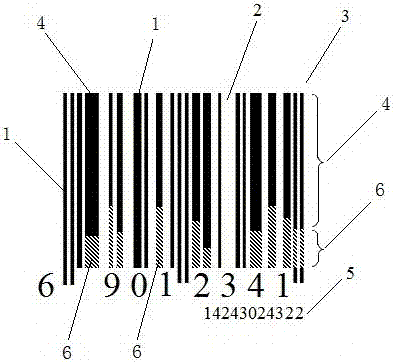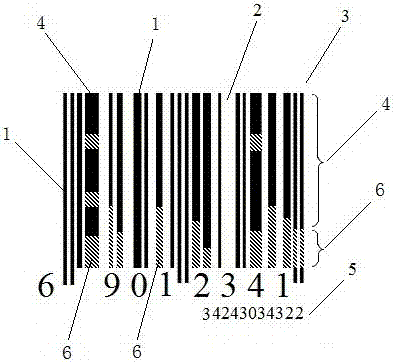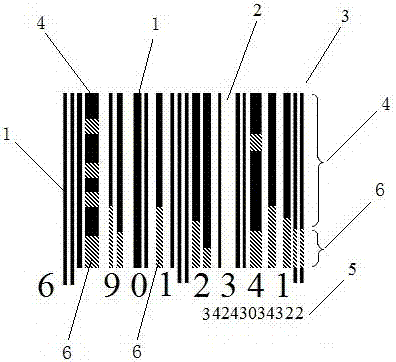Two-in-one commodity barcode
A commodity barcode and two-in-one technology, which is applied in the field of two-in-one commodity barcodes, can solve the problems of barcode grade reduction, high recognition misjudgment rate, and low grade, so as to reduce equipment investment, reduce manufacturing costs, and increase production speed. Effect
- Summary
- Abstract
- Description
- Claims
- Application Information
AI Technical Summary
Problems solved by technology
Method used
Image
Examples
Embodiment 1
[0046] figure 1 , Figure 4 As shown, the standard size of the current commodity barcode, that is, the one-dimensional barcode (3) is 37.29mm×26.26mm, and the magnification ratio is 0.9-2.0. When the printing area permits, you can choose a magnification above 1.0 to print a one-dimensional barcode⑶.
[0047] In order to make the commodity barcode described in the national standard GB12904-2003, that is, a one-dimensional barcode shared by tens of thousands of products (3)—fixed information, it can also imply logistics codes, lottery codes, traceability codes, etc. that are unique, Variable data unique to each product (5)——variable information. Such as figure 1 As shown, some light-colored line segments (6) representing variable data (5) can be printed on some bars (1) in the one-dimensional barcode (3) according to some custom rules, so that the originally pure black bars (1) can be transformed into Segmented bars that are spliced by black and gray segments ⑴. The ref...
Embodiment 2
[0069] like figure 2 shown in figure 1 On the basis, two light-colored line segments ⑹ are added to the 10-billion-digit bar ⑴, so that one bar ⑴ has three light-colored line segments ⑹, so the length of the light-colored line segment ⑹ (or the top position Coordinate number Y) and its quantity can be combined and calculated, expressed as the number 3. Add another light-colored line segment ⑹ on the ten-thousand-digit bar ⑴, so that one bar ⑴ has two light-colored line segments ⑹, so the length of the light-colored line segment ⑹ (or the coordinate number Y of the top position) and Their quantities can be combined and expressed as the number 3. Of course, one of the light-colored line segments (6) can also be used as a check code.
[0070] The rest of the steps in this embodiment are the same as in Embodiment 1.
Embodiment 3
[0072] like image 3 As shown, a bar (1) representing tens of billions of digits can be divided into ten equal parts (middle section) according to the order from bottom to top, that is, divided into 10 module units, and each equal part (module unit) 1mm, the light-colored line segment ⑹ represents 0, and the dark-colored line segment ⑷ represents 1, then the maximum binary code capacity of the ten positions on one bar ⑴ is 2 10 , that is, 1024 combinations.
[0073] In this way, one EAN-13 code has a coding capacity of 1024 to the power of 13 variable data (5), which is of course an astronomical quantity, which can fully meet the needs of one code per piece of global commodities.
PUM
 Login to View More
Login to View More Abstract
Description
Claims
Application Information
 Login to View More
Login to View More - R&D
- Intellectual Property
- Life Sciences
- Materials
- Tech Scout
- Unparalleled Data Quality
- Higher Quality Content
- 60% Fewer Hallucinations
Browse by: Latest US Patents, China's latest patents, Technical Efficacy Thesaurus, Application Domain, Technology Topic, Popular Technical Reports.
© 2025 PatSnap. All rights reserved.Legal|Privacy policy|Modern Slavery Act Transparency Statement|Sitemap|About US| Contact US: help@patsnap.com



